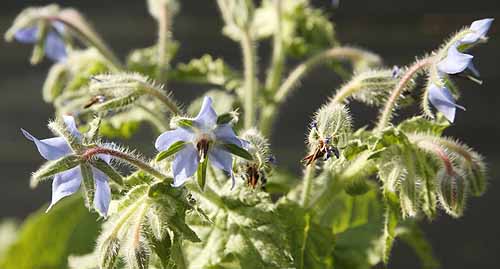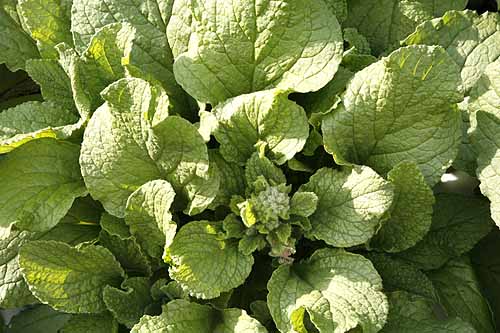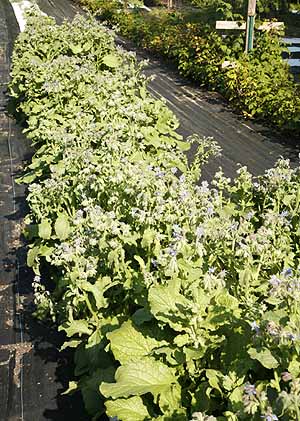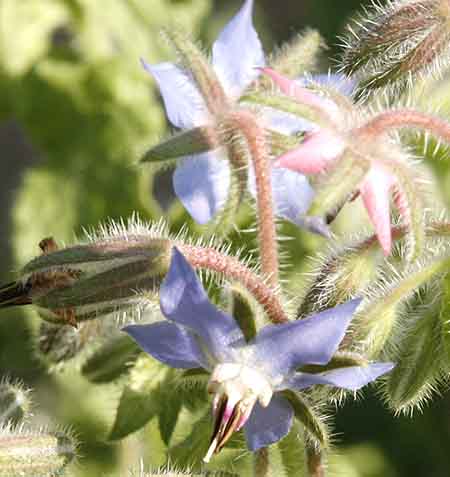Borage is an interesting plant with star like blue flowers and deeply veined dramatic leaves. It needs full sun and some water but will tolerate almost any soil type and does well on poor soil. Its flowers are loved by butterflies, bees and many other beneficial insects. It is covered in stiff hairs that make the plant stand out and almost shimmer like silver in some lights. These same hairs protect it from browsing by wildlife and the continual production of flowers from early summer until frost ensure that the garden will always have some flowers. Easy to grow and very little maintenance once established. May self seed in ideal locations.
Description of Borage (Borago officinalis)
A large annual plant that begins by producing large very textured mid green
leaves. These are basically oval in shape with a pointed end and mid to deep
green in color, deeply veined, wrinkled. Leaves can be up to 5 inches long and
3 inches broad and are covered with stout hairs on the upper surface and lower
veins that making them slightly prickly and unpleasant to handle. Flower stems
begin to arise in late spring and early summer. Flower buds are already formed
at the top of the stems even before they begin to rise from the basal leaf mass.
Stems are rise to 3 feet in height are stiff succulent hollow much branched
and covered with stiff hairs. Flowers are born on individual hairy stems, beginning
with drooping oval five part calyx that opens to produce a bright blue five
petaled star shaped flower with white center and prominent cone of black and
purple anthers in the center. Flowers bloom from early summer until frost kill.
Seeds are brownish-black nutlets. Flower branches continue to grow throughout
the season and plants can become sprawled if not staked.
HOW TO GROW Borage (Borago officinalis).
Location and Care
Full sun and some watering are required for best results. Although Borage will
tolerate some shade the plants tend to be more spindly and fall over easily.
Not fussy about soil type will grow on almost anything provided it is not waterlogged.
Ideally it likes loose stony or sandy soils that are well drained. Flowers on
poorer soils tend to be a deeper shade of blue. Pick your location well as borage
develops a thick tap root and does not take well to transplanting.
The thick hollow stems and succulent nature of the plant means that it tends
to fall over once it reaches 2 feet in height especially after high winds from
a storm. Staking larger plants is recommended or plants will sprawl, when this
happens lower branches tend to become infected with mildew and turn black. For
best results keep upright and allow for good air flow at base of plants. Borage
can take up a lot of room once it begins to mature so chose carefully so it
does not overwhelm any nearby plants. Use gloves when handling seedlings or
plants to avoid irritating hairs. Will self seed in ideal conditions.
Growing Borage (Borago officinalis) from Seed.
Best sown directly in the garden. Prepare area, remove all weeds and especially
perennial roots. Plant seeds about 15 inches apart with 3 feet between rows
around the time of last frost or just slightly before. Seeds can also be sown
in late fall for early spring germination. Water well until seeds germinate
usually about 5-10 days. Thin back or transplant when plants are large enough
to handle and water regularly for best results. Once leaves have begun to expand
they tend to suppress any nearby weeds. Watering with a soaker hose is best
option. Use gloves when handling seedlings or plants to avoid irritating hairs.
Starting indoors is not recommended as borage does not transplant well as they develop a stout tap root that does not like to be moved. Direct sowing is usually very successful.
Medical uses of Borage (Borago officinalis).
The leaves and to a lesser extent the flowers are used to treat fevers, chest
congestion and lung complaints. It also has a beneficial effect on the mind
being used to dispel melancholy and induce euphoria. The succulent strong nature
of the leaves have a very cooling saline effect and it is used to sooth irritated
and damaged tissues.
It can also stimulate the kidneys and produce a diuretic effect and so is sued to help carry off feverish catarrhs. Used mostly as a tea of the fresh or dried leaves. Externally the leaves are used as a poultice for inflammatory swellings and inflamed leg veins.
Culinary uses of Borage (Borago officinalis).
The young leaves can be used as a pot herb or added to salads they have a crunchy,
salty slightly cucumber flavor. Only young leaves are used before the irritating
hairs have grown. Alternately the stems can be used after having the outer coating
pealed off. These are very cooling and crunch on hot summer days. Both the leaves
and stalks can be used to flavor wine drinks. The flowers can be used in salads
or decoratively in summer fruit drinks. They can also be candied and used in
cake decorations. They are also used as a food coloring, especially specialty
vinegars.
Both flowers and leaves can be used to make a refreshing tea. The seeds have
high levels of gamma-linolenic acid but due to the intermittent ripening of
the seeds are not a commercial viable crop.
Companion planting
Many reports suggest that growing borage near strawberries, tomatoes and squash
can help deter Japanese beetles and tomato hornworms.










